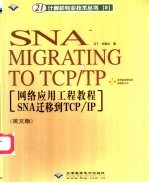图书介绍
网络应用工程教程 SNA 迁移到 TCP/TP 英文版PDF|Epub|txt|kindle电子书版本网盘下载

- (美)马丁·布莱尔著 著
- 出版社: 北京:北京希望电子出版社
- ISBN:7900071164
- 出版时间:2001
- 标注页数:295页
- 文件大小:21MB
- 文件页数:307页
- 主题词:
PDF下载
下载说明
网络应用工程教程 SNA 迁移到 TCP/TP 英文版PDF格式电子书版下载
下载的文件为RAR压缩包。需要使用解压软件进行解压得到PDF格式图书。建议使用BT下载工具Free Download Manager进行下载,简称FDM(免费,没有广告,支持多平台)。本站资源全部打包为BT种子。所以需要使用专业的BT下载软件进行下载。如BitComet qBittorrent uTorrent等BT下载工具。迅雷目前由于本站不是热门资源。不推荐使用!后期资源热门了。安装了迅雷也可以迅雷进行下载!
(文件页数 要大于 标注页数,上中下等多册电子书除外)
注意:本站所有压缩包均有解压码: 点击下载压缩包解压工具
图书目录
PART ONE Protocol interaction:Planning the subarea to IP Migration1
CHAPTER 1 SNA and TCP/IP protocol integration2
1.1 Integration at the physical layer4
1.2 Integration at the link layer4
1.3 Integration at the network layer5
1.4 Choosing the integration layer5
1.5 Choosing the backbone protocol7
CHAPTER 2 Introduction to IBM e-business solutions8
2.1 LEN and APPN9
2.2 High Performance Routing (HPR)13
2.2.1 Automatic network routing (ANR)14
2.2.2 Rapid transport protocol (RTP)16
2.3 Names in an APPN environment18
2.3.1 Network accessible unit18
2.3.2 Network identifiers18
2.3.3 Network names18
2.3.4 Network-qualified names18
2.4 Addressing in APPN19
2.4.1 Addresses in subarea networks19
2.4.2 Addresses in APPN networks19
2.4.3 Addresses in HPR networks19
2.6.1 APPN network node20
2.6 APPN node types20
2.5 Domains20
2.6.2 APPN end node21
2.6.3 LEN node22
2.6.4 Branch extender node22
2.6.5 Virtual routing node22
2.6.6 Border node23
2.6.7 HPR node24
2.7 Mixed environments24
2.7.1 APPN and subarea24
2.7.2 HPR and APPN25
CHAPTER 3 TCP/IP overview26
3.1 The beginnings and growth of TCP/IP27
3.2 TCP/IP architecture29
3.3 TCP/IP internetwork layer protocols30
3.3.1 Internet Protocol(IP)30
3.3.2 Internet Control Message Protocol(ICMP)40
3.3.3 Interfacing with the network layer40
3.4 TCP/IP transport layer protocols and interfaces41
3.4.1 Ports and sockets42
3.4.2 The sockets application programming interface42
3.4.3 User Datagram Protocol(UDP)43
3.4.4 Transmission Control Protocol(TCP)43
3.5.2 Reverse mapping45
3.5.1 Mapping domain names to IP addresses45
3.5 Domain name system45
3.6 Routing protocols46
3.6.1 Routing Information Protocol (RIP)46
3.6.2 Open Shortest Path First(OSPF)47
3.7 TCP/IP and Internet security47
3.7.1 Secure Sockets Layer(SSL)48
3.7.2 Firewalls48
3.7.3 IP Security Architecture(IPSec)51
3.7.4 Virtual private networks52
3.8.1 Resource Reservation Protocol(RSVP)53
3.8 Real-time application support and Quality of Service53
3.8.2 Quality of Service54
CHAPTER 4 SNA transport in an IP network56
4.1 Options for carrying SNA traffic over IP57
4.1.1 Data link switching57
4.1.2 AnyNet and MPTN60
4.1.3 Enterprise Extender65
4.1.4 Telnet/327067
4.1.5 Host On-Demand68
4.2 Choosing the appropriate integration mechanism and configuration70
4.2.1 AnyNet vs. DLSw vs.Enterprise Extender70
4.2.2 Telnet/327073
CHAPTER 5 Enterprise Extender76
5.1 Benefits of Enterprise Extender77
5.1.1 Failure protection77
5.1.2 Class of service78
5.1.3 Flow and congestion control78
5.1.4 Usability and cost effectiveness79
5.2 Enterprise Extender description79
5.2.1 Enterprise Extender TCP/IP protocol usage79
5.2.2 Enterprise Extender implementation80
5.2.3 A restriction to be aware of82
5.2.4 Responsive mode adaptive rated-based flow control83
5.3.1 Communications Server for OS/39084
5.3 Enterprise Extender implementation84
5.3.2 Communications Server for Windows NT87
5.3.3 Communications Server for AIX87
5.3.4 The 221X router family87
5.3.5 Cisco routers88
5.4 Planning for Enterprise Extender88
5.4.1 The IP backbone as an APPN Connection Network88
5.4.2 EE within the sysplex89
5.4.3 Connecting branches to hosts93
5.4.4 Running EE in the workstation95
5.4.5 Securing Enterprise Extender links with IPSec96
PART TWO Implementation details:A migration scenario98
CHAPTER 6 Subarea network100
6.1 Topology101
6.1.1 Data center101
6.1.2 Physical network103
6.1.3 Clients, workstations, and a Telnet server103
6.2 Preparation of the subarea network for the project104
6.2.1 Session transmission priority104
6.2.2 Prepare a model application program definition106
6.2.3 Subarea searches107
6.2.4 Buffer usage in VTAM107
6.2.5 Verify PATHTABs in NCPs108
6.2.6 Verify LU6.2 MODEs in the workstations108
6.2.7 Get current maintenance level109
CHAPTER 7 APPN and sysplex within the data center110
7.1 Planning for the move to APPN111
7.1.1 Dynamic definitions111
7.1.2 Roles and responsibilities of VTAM and NCP112
7.1.3 Naming conventions112
7.1.4 Dynamically defining switched resources113
7.1.5 APPNCOS start option and table113
7.1.6 Transmission group profiles113
7.1.7 ISTINCLM and user-defined logmode table requirements114
7.1.8 VTAM to VTAM connections114
7.2.1 Migrating our CMC hosts to ICN115
7.2 Migrating from subarea to APPN115
7.2.2 VTAM definitions for primary ICN116
7.2.3 APPN-related start options117
7.2.4 APPN COS and TG profiles117
7.2.5 CDRMS and adjacent SSCP tables118
7.2.6 Migrating our data hosts to pure ENs118
7.2.7 Topology and directory databases119
7.2.8 Checking our network status119
7.2.9 Topology121
7.2.10 Changing CTCs to MPC+ links123
7.3 Observations125
CHAPTER 8 IP network description130
8.1 Topology131
8.1.1 IP hosts and additional hardware133
8.1.2 Physical links134
8.2 VIPA138
8.3 Routing infrastructure(OSPF)140
8.3.1 Configuring OSPF140
8.3.2 Routing table displays143
CHAPTER 9 Enterprise Extender configuration146
9.1 Enterprise Extender topology147
9.2.1 TCP/IP configuration changes149
9.2.2 Defining EE on our NNs149
9.2 Configuring EE on CS for OS/390149
9.2.3 Defining EE on our ENs152
9.3 Configuring Branch Extender and EE on CS for Windows NT154
9.3.1 Configuring the MAC address154
9.3.2 Configuring the node155
9.3.3 Configuring the EEDLC port155
9.3.4 Configuring the upstream links155
9.3.5 Verification of the configuration155
9.4 Configuring EE on the routers158
9.4.1 Configuring EE on the Cisco 7507159
9.4.2 Configuring the IBM 2210163
9.5 Configuring EE on AIX168
9.5.1 AIX configuration file169
CHAPTER 10 SNI replacement174
10.1 Planning for SNI replacement175
10.1.1 APPN in your own network176
10.1.2 APPN in your partner s network176
10.1.3 Access control in your network177
10.1.4 Secure the connection177
10.2 Implementing SNI replacement177
10.2.1 Change the SNI FID4 connection to APPN EBN FID2178
10.2.2 Adding our parallel EE links182
10.3 HPR to subarea connectivity problem192
10.3.1 After EE has been implemented between branches and host193
CHAPTER 11 Performance consideration198
11.1 Areas to look at199
11.2 Session parameters199
11.3 APPN parameters200
11.4 HPR parameters202
11.5 Transmission unit size considerations203
11.5.1 Architecture203
11.5.2 Example packet trace204
11.5.3 SNA compression207
APPENDIX A VTAM definitions210
A.1 APPN VTAM definitions for host 105211
A.2 APPN VTAM definitions for host 106231
A.3 APPN VTAM defintions for host 223238
A.4 APPN VTAM definitions for host 222241
A.5 APPN VTAM definitions for host 221250
A.6 EE VTAM start list for hosts 105,106,221,222,223258
A.7 VTAM start list for Enterprise Extender260
A.8 Adjacent cluster261
A.9 TCP/IP profile for 105262
A.10 TCP/IP profile for 106267
A.11 TCP/IP profile for 221274
APPENDIX B Configuring CS for Windows NT and Pcomm280
B.1 Sample definition of CS for Windows NT Branch Extender with EE links281
B.2 Definitions for PComm 4.3291